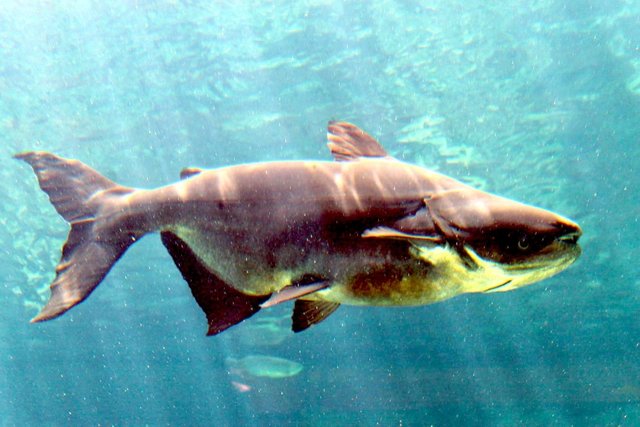Endangered : "The Mistery of MEKONG"

INTRO
The Mekong giant catfish (Pangasianodon (Pangasius) gigas) is one of largest freshwater fish in the world, measuring up to 3 m in length and weighing in excess of 300 kg. It is endemic to the Mekong basin.
The vernacular name “Pla Buk” has been known to the Thai and Lao people since time immemorial. The word “Buk” may be derived from “Huk”, a term meaning big to the Mekong riparian communities. The English common name, “Mekong giant catfish” also indicates the largeness of its body size.
The Mekong giant catfish (Pangasianodon gigas) species is listed as critically endangered by the World Conservation Union (IUCN), which means it faces a high risk of extinction in the wild. The rare specimen, captured in Chiang Khong district, is the largest since Thailand began keeping records in 1981
HABITATS
The Mekong giant catfish is a freshwater fish, and has not been caught in the brackish water estuary of the Mekong River. The known habitat of this species is the main stream where the water depth is 10 m or more. The fish particularly prefers rocky or gravel substrate, and sometimes underwater caves.
FEEDING
After the yolk sac has been absorbed, the hatchlings are fed zooplankton (Cyclops, Moina, Daphnia) for two weeks. The fry are cannibalistic, after one year the feeding mode becomes herbivorous.

The Mekong giant catfish is one of the fastest growing freshwater fish species in the world. The maximum recorded size of the Mekong giant catfish is 300 kg and 3 m in length. The disappearance of the Mekong giant catfish is a sign of the slow decline of environmental conditions throughout the river. Like many species in the Mekong, the giant catfish needs great stretches of the river to migrate seasonally—and it must have specific water quality and flow to move through its lifecycles of spawning, eating, and breeding.
The giant catfish is a flagship species that highlights the need to protect threatened species and limit habitat loss. The giant catfish is also a potentially valuable aquaculture and commercial aquarium/zoo species. Even so, the wild populations of Mekong giant catfish are declining rapidly and the species may go extinct in the near future.
The Mekong giant catfish is one of the largest and most vulnerable freshwater species in the world. It is also a culturally important species. The Mekong giant catfish symbolizes the ecological integrity of the Mekong River, because the species is so vulnerable to fishing pressure and changes in the river environment. Thus, the status of the species is one indicator of the health of the river. The recovery of the species is an important part of the sustainable management of the Mekong River Basin.
That's why the Mekong giant catfish so special and so important to keep it in the wild.

SAVE MEKONG
References
Mattson, Niklas S.; Buakhamvongsa, Kongpheng; Sukumasavin, Naruepon; Tuan, Nguyen; Vibol, Ouk (2002). "Mekong giant fish species: on their management and biology" (PDF).
"Giant Mekong catfish off the hook". BBC News. 2006-06-10. Retrieved 2006-06-29.
"Giant Catfish Critically Endangered, Group Says". National Geographic News. 2003-11-18. Retrieved 2006-06-29.
Owen, James (2005-06-29). "Grizzly Bear-Size Catfish Caught in Thailand". National Geographic News. Retrieved 2006-06-29.
https://en.wikipedia.org/wiki/Mekong_giant_catfish
Pictures References
http://otlibrary.com/mekong-giant-catfish/
http://www.nationalgeographic.com.au/mekong-giant-catfish/
http://news.bbc.co.uk/2/hi/asia-pacific/5068206.stm
Thank you for reading this article, hope you guys enjoy it.
if you don't mind, please upvote and support this blog so we can makes another articles with a lot benefit in it.
Conozco el bagre de agua dulce, los que he visto son pequeños, no sabia que podían pesar hasta 300 Kg y 3 metros de longitud. gracias por informar..todo los días uno aprende.
thank you for coming
This post has received a 1.36 % upvote from @drotto thanks to: @thomasjug.